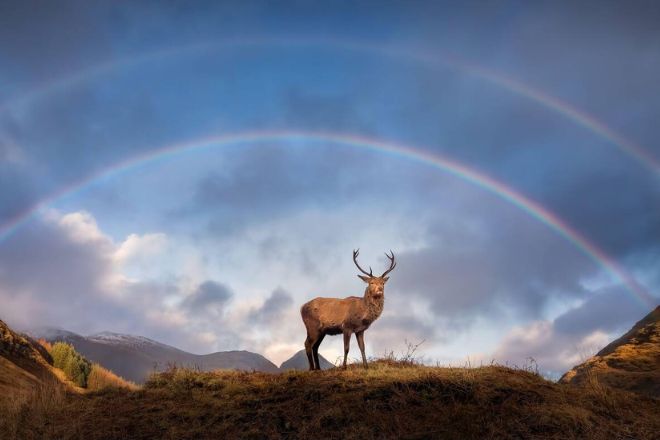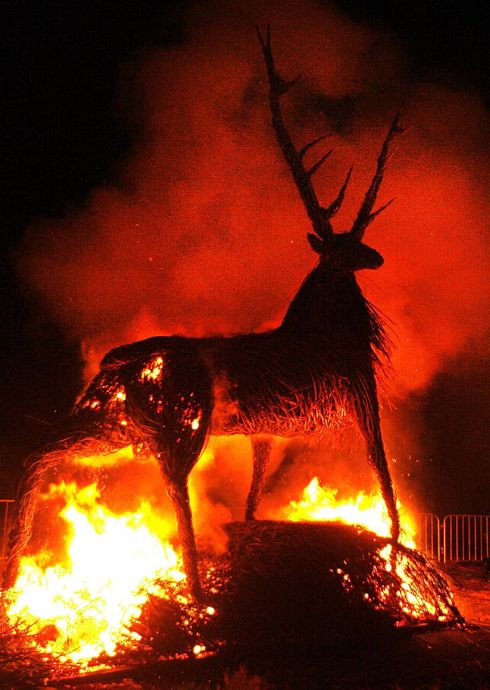
When one thinks of Scotland, images of breathtaking landscapes, rugged mountains, and mystical creatures come to mind. Among these, the Scottish stag stands out as a majestic symbol of the country’s wilderness and beauty. In this blog post, we will take a closer look at the Scottish stag, exploring its mythology, significance, and cultural symbolism.

The stag has played a significant role in mythology and legends throughout the world, including Scotland. In Celtic mythology, the stag was seen as a powerful and regal creature, often associated with the god Cernunnos, who was the god of the forest and the hunt. In Norse mythology, the stag was associated with the god Odin, who was said to be accompanied by two wolves and a stag on his journeys through the forest.

In Scottish mythology, the stag was often seen as a protector of the forest, a symbol of strength, and a creature with mystical powers. According to legend, the Scottish stag was said to possess the ability to cross between the worlds of the living and the dead, making it a symbol of life and death, and a bridge between the physical and spiritual realms.

Burning the stag is a ritual that has been practiced in Scotland for centuries, and it holds significant cultural and symbolic meaning. The practice involves the burning of a large wooden effigy of a stag, often during festivals or celebrations such as the Beltane festival. The burning of the stag symbolizes the end of winter and the beginning of spring, and it is seen as a way to purify the land and bring new life to the earth. It is also believed to honor the stag and to give thanks for the sustenance it provides through hunting and food.
The stag has various meanings in Christianity, representing Christ as the Good Shepherd, sacrifice, purity, innocence, and strength. Stag antlers are also symbolic and associated with wisdom and nobility in Celtic mythology. Christianity incorporates symbolism from other cultures, such as Cernunnos, a pagan god sometimes seen as a precursor to Christ. Palm Sunday commemorates Jesus’ entry into Jerusalem, while Holy Thursday emphasizes humility, service, and the importance of baptism.
The stag is not universally considered a mythical creature, but it does have a significant role in various mythologies and cultures around the world. In Celtic mythology, for example, the stag is associated with the god Cernunnos and the goddess Elen of the Ways, among others. The stag is also prominent in the mythology of the Native American tribes, where it is often depicted as a symbol of strength, courage, and spirituality.
However, the stag is not typically considered a completely fictional or imaginary creature like other mythical creatures. It is a real animal that exists in the natural world, and it has been known to humans for thousands of years. While the stag has played an important role in many cultures’ myths and legends, it is not necessarily a creature that is exclusive to the realm of myth and fantasy.
Landseer’s portrayal of the Scottish stag as regal and powerful made it culturally significant, and the “monarch of the glen” remains an iconic symbol of Scottish culture. The artwork raises questions about the human-nature relationship, particularly hunting’s controversial nature and potential harm, and pays tribute to the Scottish stag’s significance.

“High on a throne of rocks, his castle’s seat,
In silent grandeur, stood the Monarch Stag;
Whose antler’d crown and proud, majestic front
Had awed the forest’s tenants many a year.
And there he stood, in all his native strength,
As if, a king, he calmly ruled the scene”
“Around him, hills, and woods, and glens were spread,
And far below, the loch’s still waters lay;
While in the distance, towering mountains rose,
With their sharp summits lost amid the clouds”
“But not a sound disturb’d the still repose,
Save the faint murmur of the mountain rill;
Or the low sighing of the evening breeze,
That gently stirr’d the branches of the trees”
“And thus he stood, the lordly Monarch Stag,
In all his wild, unbroken majesty;
A fitting emblem of our Scottish land,
And of the glorious freedom of the hills”
“The Monarch of the Glen” by Sir Edwin Landseer is a famous cultural reference to the Scottish stag. Landseer was a prominent 19th-century artist known for his depictions of animals, and the poem celebrates the beauty and power of the Scottish stag. Inspired by his own hunting experiences, the poem portrays the stag as a majestic ruler of the Scottish landscape, embodying the rugged beauty and wildness of Scotland’s terrain.
Landseer’s portrayal of the Scottish stag as a regal and powerful creature cemented its cultural significance, and the image of the “monarch of the glen” remains an iconic symbol of Scottish culture. “The Monarch of the Glen” also raises questions about the relationship between humans and nature, acknowledging the controversial nature of hunting and the potential for harm. It is a powerful tribute to the Scottish stag and testament to its cultural significance.
In addition to its cultural and mythical significance, the Scottish stag has also played a role in religious art throughout history. From the stained glass windows of medieval cathedrals to illuminated manuscripts, the stag has been depicted in Christian art as a symbol of Christ’s purity and resurrection.
One famous example is the Book of Kells, a medieval manuscript that contains intricate illustrations of animals and other creatures, including a depiction of a stag. The stag in the Book of Kells is shown with its head turned back, which was a common symbol in Christian art that represented the soul’s turning back to God.

The Scottish stag has a significant history in hunting and sport. Originally reserved for nobility, it eventually became a popular sport for all classes. Today, hunting remains a contentious topic in Scotland, with some considering it a vital cultural practice and others condemning it as outdated and cruel.
The Scottish stag is a symbol of Scotland’s natural beauty and wilderness, despite its association with hunting and sport. Tourists visit Scotland to witness the majestic creatures in their habitat, and sightings are considered rare and special. For Scots, stags are a common sight, but remain a powerful emblem of the country’s identity, rugged beauty, wild landscapes, and cultural heritage.
firstly, If you are interested in hunting a stag in Scotland, you may need to obtain a hunting permit or license, as well as comply with the regulations and guidelines set by the Scottish government and local authorities.
and then finally, whent the day arrives, you want to make sure you’re dressed for the occasion. This means sporting some traditional Scottish garb, including Ghillie brogues for your shoes, a kilt for your lower half, and a Ghillie shirt to top it off. But the outfit isn’t complete without some key accessories like a Sgian Dubh tucked into your sock or boot. This small, ornamental knife is an important part of traditional Scottish dress and will definitely make you feel like a true Scotsman. And don’t forget about the Sporran, a small pouch worn around the waist that is both stylish and functional. You’ll want to keep your essentials, like your phone, wallet, and snacks, within reach during the hunt.
Lastly, you’ll want to make sure you have a warm jacket and hat to protect you from the Scottish weather. It can get pretty chilly out there, even in the summer months. So, grab your Tweed Jacket and a traditional Tam o’ Shanter hat to keep yourself cozy and stylish.
The Scottish Stag has long been an important symbol of Scotland’s wild and rugged landscapes, as well as its proud and independent spirit. It is also associated with hunting and the aristocratic tradition of deer stalking.
Yes, the Scottish Stag is a real animal, also known as the Red Deer, and is native to Scotland. It is the largest wild deer species in the UK.
In Scottish mythology, the Scottish Stag is often associated with the Cailleach, a goddess figure who is said to control the changing of the seasons. The stag is also sometimes seen as a messenger from the spirit world.
“The Monarch of the Glen” symbolizes the power and majesty of the Scottish Stag, as well as its association with Scotland’s rugged and wild landscapes. It has become an important cultural symbol in Scotland and beyond.
Input your search keywords and press Enter.
